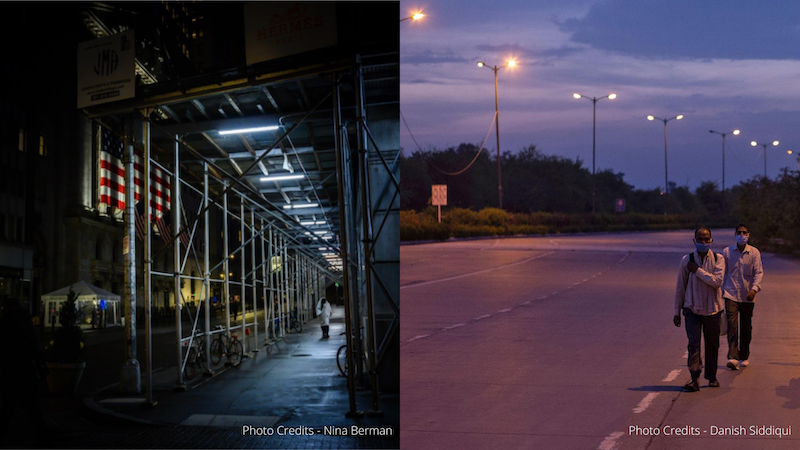Photojournalism and the Covid-19 Crisis

Iconic images shape how we remember significant moments in history. With indoor confinement becoming a new reality during the recent months of the coronavirus pandemic, images evoke ways for citizens to remember and significantly rethink the meaning of shared living and urban public space.
The role, scope and challenges of photojournalism in bearing witness and recording the current pandemic was the subject of an online panel entitled The Lens as Witness: Photojournalism in the Times of Covid-19, organized on September 30, 2020, by Columbia Global Centers | Mumbai. The panel featured documentary photographer and Columbia University Professor of Journalism, Nina Berman, and Pulitzer Prize-winning photojournalist and head of the Reuters Pictures team in India, Danish Siddiqui, and was moderated by Dr. Ravina Aggarwal, Director, Columbia Global Centers | Mumbai. Drawing from their experiences in facing a crisis so different from the ones on which they had previously worked, panelists reflected on the different aspects of the pandemic they had chosen to cover.
A longtime New Yorker, Professor Berman presented her personal reflections and the images she had captured of the city in the initial days of the lockdown. She described a sense of anxiety and emptiness that gripped New York, and compared the atmosphere with the AIDS crisis of the 1980s and the days after September 11, previous traumas that the city had witnessed and held in living memory. Communicating a broader sense of fragility and vulnerability, Professor Berman offered a poignant portrait of a city that was deeply struck and hurting through pictures of homelessness, isolation, closed places of worship, refrigerated morgue trucks and scenes of nurses protesting lack of supplies and mistreatment; that also marked the crisis of economy and information running parallel to the healthcare crisis. Trying to preserve public scenes that soon turned alien such as soccer fields and graduation ceremonies, her works also captured the transition to desertion, masks, and daily rituals that acknowledged healthcare workers.
Mr. Siddiqui’s presentation traced his journey of reportage for Reuters from New Delhi to the hinterlands of rural Bihar in India. Turning his lens first to India’s capital city where he is based, Mr. Siddiqui documented the eerie emptiness of the once bustling streets, queues for food that began to lengthen as the lockdown left many daily wage earners without income, and the desperate migrant exodus that followed. In following the story of a migrant family from New Delhi to their village in Madhya Pradesh, he shared glimpses from their struggle to make ends meet and, burdened by mounting debt, the pain of being compelled to return to the city in search for work again. While much of the nation’s gaze was fixed on its metropolises, Mr. Siddiqui travelled to Bhagalpur, a Tier-2 city in Bihar and reported from its Covid-19 hospital, overwhelmed by the task of caring for a huge population with scant resources and provisions. He even went further into primary healthcare centers in surrounding villages, recently devastated by floods, where conditions were more dire. Reflecting on his solemn pictures from graveyards and crematoriums, and comparing the grim situation to covering wars, he observed that the pandemic too did not afford dignity in death to its victims, whose personhoods were at the risk of becoming just a statistic. To give a face to these numbers, he shared a new Reuters project that documents portraits of victims from the breadth of the country in a bid to restore their dignity and identity.
In as much as the presentations shed light on the predicament of the city during the crises, they threw into relief persistent issues that are often sidelined in the imagination of cities such as stark inequalities between groups of people who use the streets, contrasts between infrastructural access and denial of dignity and space to migrant workers from rural areas and small towns whose labor is responsible for the built environment, and the vulnerability of the healthcare system in the wake of inadequate investment.
The presentations were followed by a discussion and question and answer session that covered considerations of aesthetic appeal and visual styles in the panelists’ works, experiences in building relationships with their subjects to create more authentic and sincere images, challenges to mobility and protections in working during the pandemic, importance and role of social media, and the relationship between photojournalism and activism.
Given photojournalism’s role as a sharp tool for visual storytelling, recording history, forwarding investigation and information, and raising awareness around pressing issues, Dr. Aggarwal ended the session by asking the panelists what advice they had for aspiring photojournalists and documentary photographers. Both panelists emphasized the importance of maintaining journalistic ethics and highlighted the profession’s role in amplifying social messages and giving voice to people’s stories, adding that there was space for new voices and perspectives despite the cacophony of the online world. “It’s very much a hardworking, challenging, physical profession but one that has been very meaningful - meaningful to the people that are in the pictures you make, meaningful in terms of the colleagues and the support of the community. Everyone I know who goes into this profession wants in some way to see a better world,” concluded Professor Berman.